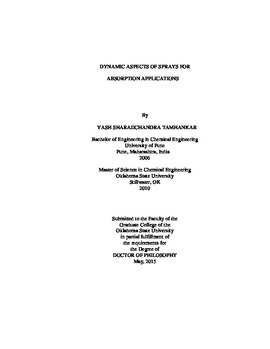| dc.contributor.advisor | Aichele, Clint P. | |
| dc.contributor.author | Tamhankar, Yash Sharadchandra | |
| dc.date.accessioned | 2016-01-20T15:45:39Z | |
| dc.date.available | 2016-01-20T15:45:39Z | |
| dc.date.issued | 2015-05 | |
| dc.identifier.uri | https://hdl.handle.net/11244/25751 | |
| dc.description.abstract | Spray columns show potential for absorption applications such as CO2 capture because of the low gas phase pressure drop and resistivity to the corrosive action of amine solvents such as Monoethanolamine (MEA) due to the lack of internal hardware. Spray absorption data in terms of mass transfer coefficients is needed for robust design, whereas dropsize data and interfacial area data are required to improve the current understanding of spray absorption. The aim of this study was to measure spray absorption rates, drop size, and surface area for the CO2-MEA system in a laboratory spray column. In specific, the study was conducted to elucidate the effect of increasing MEA concentration on spray absorption of CO2. Further, the interfacial area inside the Spray column was ascertained by absorbing CO2 in a low normality Sodium hydroxide (NaOH) solution as a measure of the spray efficiency. Absorption rates for the CO2-MEA system were found to decrease with increasing inlet loading on one hand, and increase with L/G ratio, and MEA concentration on the other. Dropsize measurements were found to be practically independent of the inlet loading. A new methodology to compute planar area from dropsize measurements was developed. The computed planar surface areas were found to be comparable for the two MEA concentrations tested. Free MEA content was thus found to dominate the spray absorption process. Increasing MEA concentration for spray absorption of CO2 may be a feasible option. Interfacial area measurements inside the spray column were found to be strongly dependent on the contactor height. The interfacial area in sprays was found comparable to packed columns at low gas-liquid contact heights. Data for both the CO2-MEA and CO2-NaOH system, points to a large degree of mass transfer in the region in the immediate vicinity of the nozzle tip. Short contact spray columns for absorption applications are thus recommended. | |
| dc.format | application/pdf | |
| dc.language | en_US | |
| dc.rights | Copyright is held by the author who has granted the Oklahoma State University Library the non-exclusive right to share this material in its institutional repository. Contact Digital Library Services at lib-dls@okstate.edu or 405-744-9161 for the permission policy on the use, reproduction or distribution of this material. | |
| dc.title | Dynamic aspects of sprays for absorption applications | |
| dc.contributor.committeeMember | Whiteley, James R. | |
| dc.contributor.committeeMember | Cai, Tony | |
| dc.contributor.committeeMember | Bellmer, Danielle | |
| osu.filename | Tamhankar_okstate_0664D_13820.pdf | |
| osu.accesstype | Open Access | |
| dc.type.genre | Dissertation | |
| dc.type.material | Text | |
| thesis.degree.discipline | Chemical Engineering | |
| thesis.degree.grantor | Oklahoma State University | |
